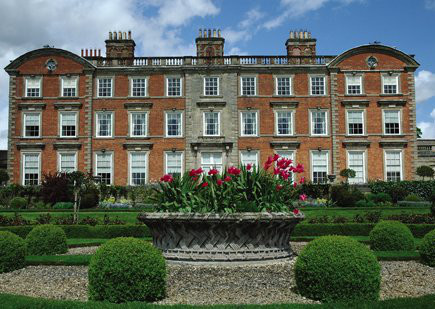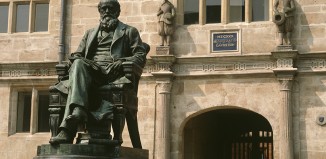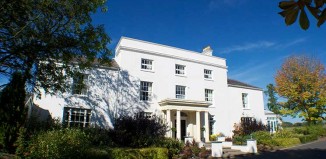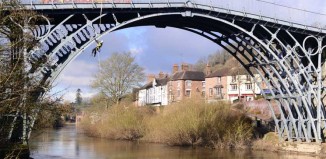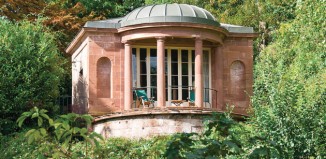Weston Park
Vicky Sartain
From the outside, Weston Park is one of those sigh-inducing stately piles – a 17th-century drama of red brick, balustrades and chimney stacks, and many, many winking windows. Appearances are, in fact, deceiving. Part hotel, art gallery, and wedding/festival/food destination, the property has evolved from its days as home to the distinguished Earls of Bradford to become a cultural and entertainment venue for the Midlands. Visitors are free to tour in traditional style, taking in interiors where paintings by Stubbs, Van Dyck, Constable and Lely complement Chippendale furniture and rare Gobelin tapestries, and they may also like to pitch a tent in Weston’s camping field or join revellers at the annual V Festival in the grounds.
“Weston was gifted to the nation in 1986 by the 7th Earl who wanted it to be enjoyed as an evolving entity, and so we have always operated on a more enterprising model than other stately properties,” explains marketing executive Andrea Webster. “It is managed by an independent charitable foundation – so all proceeds go back into maintaining and conserving the property. We don’t receive any government funding so we have to be commercially astute.”
The realities of sustaining a vast historic property in today’s climate have spurred the trustees of the Weston Park Foundation to extend the welcome beyond standard opening hours. There are also no velvet ropes here, but a free rein to experience the country life, whether it’s a picnic on the lawn or an overnight stay in one of the 28 lavish suites. The fantasy of being lord or lady of the manor for a weekend can come true, complete with your own chef and butler service. “When people check in for a night or a weekend, we’re effectively handing over the keys – it becomes their home for that time,” discloses Andrea. Part of the charm is that Weston can be enjoyed on a more leisurely basis after the doors finally close to the house tours at the end of September. “We offer Christmas season dining dates with the option that people can stay overnight on an individual basis and enjoy all the benefits that the property has to offer. We sit astride lots of different categories.”
The house was built in 1671 by Lady Elizabeth Wilbraham, a pioneer of her time whose architectural vision shaped private residences, churches and public buildings. She was in effect the first female architect. Marrying Thomas Wilbraham in the 1650s, the couple would go on to remodel Weston Park, demolishing the crumbling medieval farmhouse and building a resplendent mansion on the foundations. Elizabeth drew ideas from Palladio’s First Book of Architecture to inform her own design. “The very copy of this book survives here today, complete with the notes that she jotted as building work progressed,” says Andrea.
Since Elizabeth’s time, the property has been altered and aspects changed as is common with many stately homes. John Bridgeman, Bishop of Chester began the ‘Bridgeman era’ from the late 16th century, and the property passed in turn to his son Orlando, 1st Baronet, Lord Chief Justice and Keeper of the Great Seal of England, whose portrait is displayed as part of the property’s permanent exhibition. By the time Sir Henry Bridgeman, 5th Baronet, claimed Weston Park in the 18th century, the family had accrued vast swathes of land across the Midlands and the north. Bridgeman was free to focus on developing the property, commissioning ‘Capability’ Brown to landscape the grounds, and architect James Paine to design the Roman Bridge in Temple Wood along with the 1767 granary building, now restored into a farm shop, restaurant and art gallery.
The 2nd, 3rd and 4th Earls of the Victorian era introduced the Orangery, Loggia and East Wing, and modified the Library, Drawing Room and Tapestry Room. An increasing trend for gardening during this period inspired the creation of the Terrace and Broderie Gardens.
The Entrance Hall, the former Library in Georgian times, is an homage to the 3rd Earl’s love of all things equestrian. His vocation was Queen Victoria’s Master of the Horse, and he famously led the proceedings of the Duke of Wellington’s funeral in 1852. A painting can be seen here of the Earl at his duties, while others of an equestrian theme are painted by Stubbs and Ferneley. Not frightened to renovate rooms, the trustees redecorated in 2011 to brighten faded wallpaper, adhering to colour schemes from the past by examining layers of paper beneath.
Perhaps the most coveted treasure lies in the Breakfast Room. Not a precious jewel or item of antique furniture, the find is the burse (bag) which once contained the Great Seal of England, the original royal coat of arms used in ceremonial events. This incredibly well preserved 17th-century item still sparkles, its gold and silver thread and red tassles little faded. It was brought to the property by Sir Orlando Bridgeman who presided over the trials of those who had condemned Charles I to death. Bridgeman’s prestigious role as Keeper of the Great Seal was short-lived however: his strong sense of morality conflicted with Charles II’s request for him to supplement the finances of his various mistresses. Bridgeman daringly refused to return the burse, and had the silver Seal of England melted down into a Standing Cup, also part of Weston Park’s prized permanent exhibition.
Among various portraits of nobility are a number of charismatic females, Charles II mistresses included. In the Drawing Room is Peter Lely’s captivating portrait of Weston Park’s visionary owner, Lady Elizabeth. “She was a very proud, determined character,” says Andrea. “She had great influence and made every effort to ensure her two daughters married well.”
Visitors can wander at their leisure or opt to take a guided house tour, which looks in depth at some of the items amassed from the 16th century. In addition curator-led ‘Upstairs, Downstairs’ trips take visitors behind the scenes to explore areas of the house not normally open to the public. The outside, too, is a highlight with tours led by head gardener Martin Gee, the latest of his family’s 200-year association with the Park’s management. Out in the grounds are countless acres to explore: greenhouses with burgeoning colour, a walled garden, vast emerald lawns fringed by water and woodlands, temples and grottoes, and formal gardens for those who love the scent of roses. ‘Capability’ Brown’s natural landscape is still evident in the parkland views, the deep natural boundary, or ha-ha, to the south side, and the ‘Shrewsbury Walk’ woven through the pleasure ground. “We encourage people to come on foot or on bikes in the summer,” says Andrea. “For children there’s an adventure playground, miniature railway and family trails to follow.”
In the 1930s the stark white Regency stucco covering the house was stripped away revealing its brick elevations, a characteristic of many other Shropshire properties great and small. This drastic measure marked a dawn of change, including the donation of the property to the nation in 1986, and its rise into a multi-purpose venue. Most recently the old granary building has been restored into a contemporary art gallery and food centre. As the entry and exit point to the Park, it is already making a name for itself, offering yet another string to the bow. Whatever the reason for visiting Weston: art, architecture or gentle exercise, the idea of a hearty meal or some fresh takeaway fare on departure is too tantalising a prospect to resist.
Weston Park, Weston-under-Lizard, Nr Shifnal, Shropshire TF11 8LE.
Tel: 01952 852 100. www.weston-park.com
Open March through September. Please call or check website for details. House 1pm-5pm, closed Saturdays. Park and gardens, 10.30am-6pm.
Combined house, park and gardens entry: £8.50 adult, £7.50 senior, £6 child. Annual pass £20 adult, senior £18, child £15.

